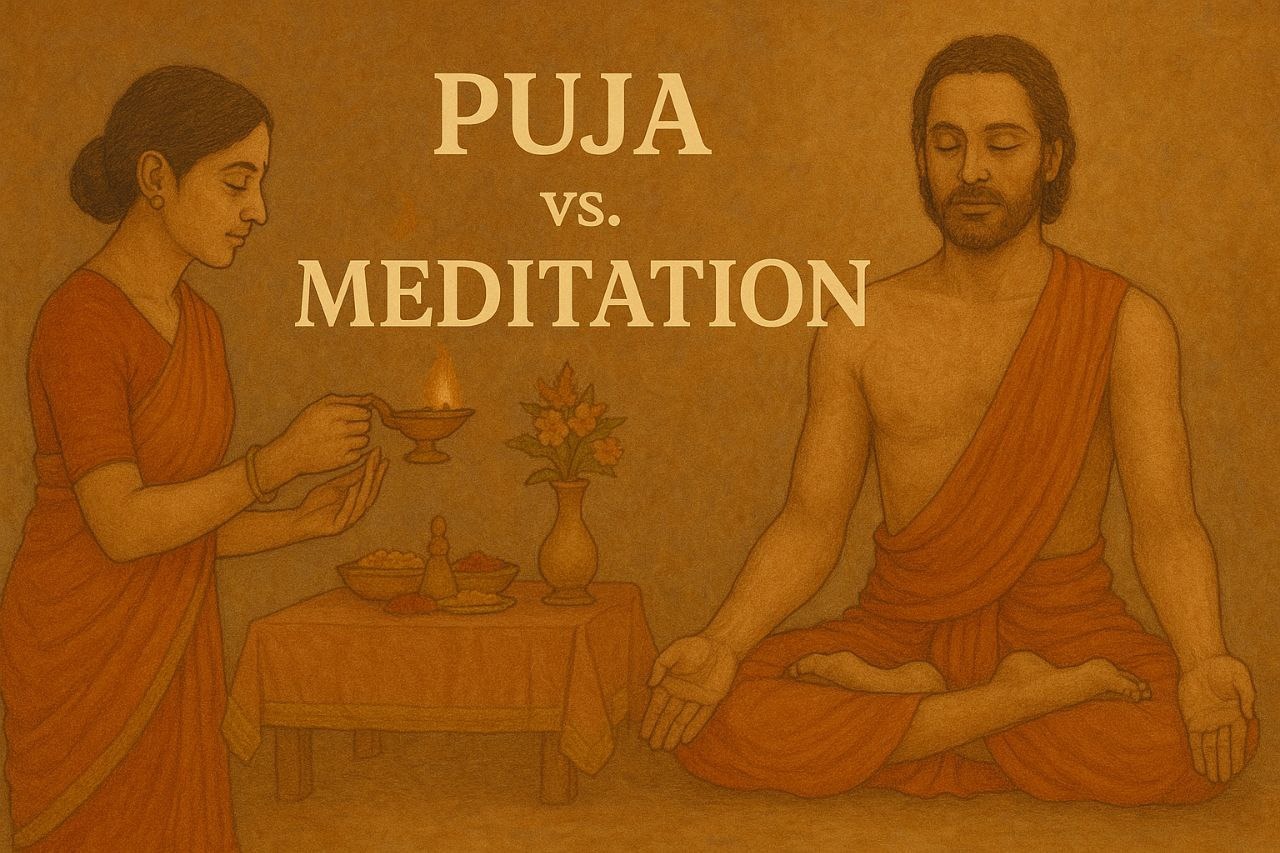Choosing: Puja vs. Meditation

In Sanatan Dharma, spiritual paths are diverse yet harmonious. Two deeply transformative practices, Puja (ritual worship) and Meditation (Dhyāna), serve as gateways to the divine. Both lead inward, but engage the soul through different languages: ritual and silence.
“Puja is the dance of devotion; meditation is the embrace of stillness. Both ask : Will you meet the divine, with song or silence?” ~ Adarsh Singh
🪔 Puja: The Path of Sacred Offering
Engages all the senses: sound, sight, touch, fragrance, taste
Rituals with intention: invoking, offering, praising, and surrendering
Utilizes form and ritual as a bridge between the seeker and the divine
Best for: those with a devotional temperament, emotional energy, or a love for dynamic expression
“In puja, your devotion becomes song; your offerings become prayer; your heart opens in form and fragrance.” ~ Adarsh Singh
🧘 Meditation: The Path of Inner Silence
Focuses inward: turning attention from form to the formless
Uses stillness and awareness: often silent, simple, and formless
Ideal for cleansing the mind and discovering the formless reality of Atman
Best for: those drawn to introspection, stillness, and the dissolution of the ego
“Meditation is not the absence of thought. It is the awakening of what watches all that thought.” ~ Adarsh Singh
🔄 How to Choose, or Combine Both
Many seekers naturally gravitate toward one path, but Sanatan wisdom invites integration:
Start with Puja, then let the ritual lead into silent meditation.
Use meditation to deepen the devotional feeling you awaken in Puja.
Alternate: puja in the morning to invoke the day, meditation in the evening to absorb wisdom and calm.
“Let ritual open the heart and silence reveal its depth. In their harmony, devotion becomes wisdom.” ~ Adarsh Singh
🧩 Matching Practice to Temperament
Each individual is unique, not just physically, but also mentally, emotionally, and spiritually. Sanatan Dharma acknowledges this diversity deeply and does not enforce a one-size-fits-all spiritual path. Instead, it encourages seekers to choose their sādhanā (spiritual practice) based on their inherent nature and temperament (svabhāva).
For those with a devotional temperament, individuals who naturally feel a sense of love, reverence, and surrender, Puja becomes a powerful tool. Engaging the senses through rituals, offerings, chants, and visualizations helps them connect with the Divine. The physical actions of Puja serve to anchor the heart in love and the mind in focus, making it easier for them to express bhakti (devotion).
On the other hand, seekers with a contemplative, introspective temperament often gravitate toward Meditation. These are individuals who prefer silence, inner inquiry, and self-awareness over external rituals. For them, the subtle art of observing thoughts, connecting with breath, and transcending the ego aligns more with their path toward realization.
Some may find both paths complement each other. A puja in the morning may quiet the mind for deeper meditation. Or meditation may lead to inner stillness that enhances the experience of puja. The key is to experiment, observe one's inner response, and allow intuition to guide the way.
“Sanatan Dharma doesn’t impose, it reveals. It doesn’t command, it invites. Choose your path not by tradition, but by truth felt within.” ~ Adarsh Singh
🌟 Modern Relevance
Puja invites presence through heart and senses, perfect in a busy, distracted world.
Meditation cultivates deep inner stability, essential when inner stillness feels rare.
Both practices are complementary tools to navigate a life of balance, clarity, and sacred alignment with Self and Universe.
“Let the outer offering expand your inner field. When you offer more love through ritual, you receive more silence through meditation.” ~ Adarsh Singh
Neither path is better, they are different notes of the same sacred song. Puja calls the heart to devotion; meditation stills the mind into awareness. Together, they harmonize action and absorption, devotion and wisdom.
Ask: What does your soul need today, light of offerings or depth of silence? Follow it and you'll experience both bring you home.
“In a ritual you invoke. In meditation you dissolve. Either way, you return to the Source you already are.” ~ Adarsh Singh
Wed Jul 23, 2025
